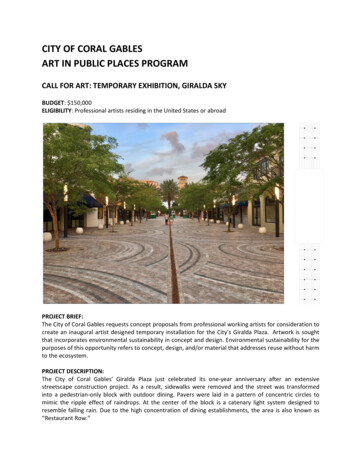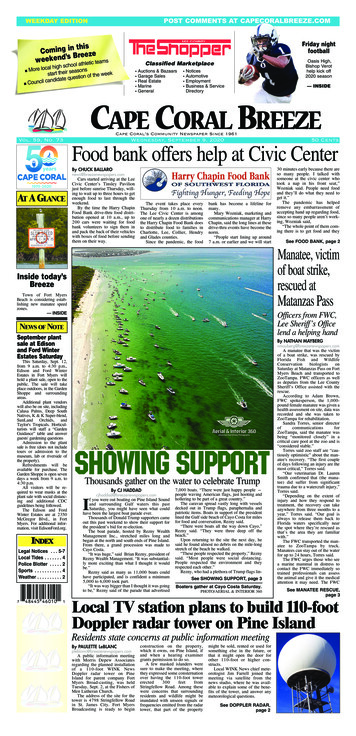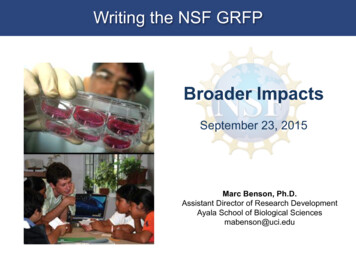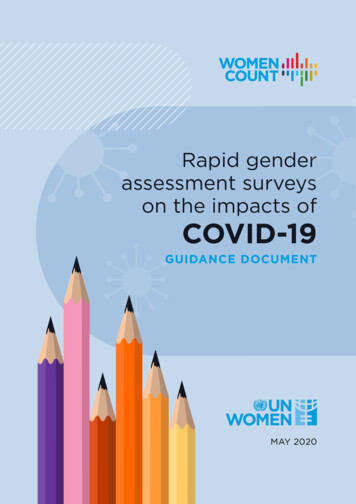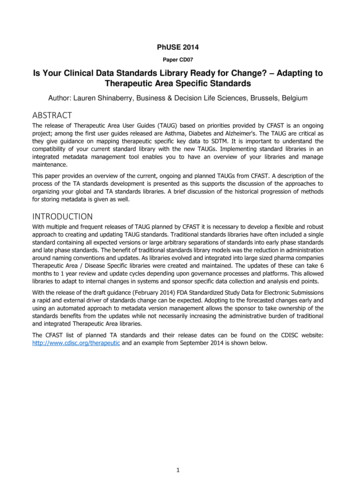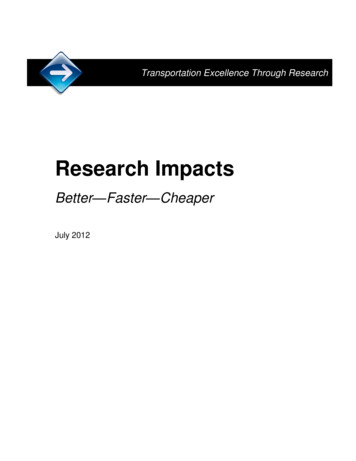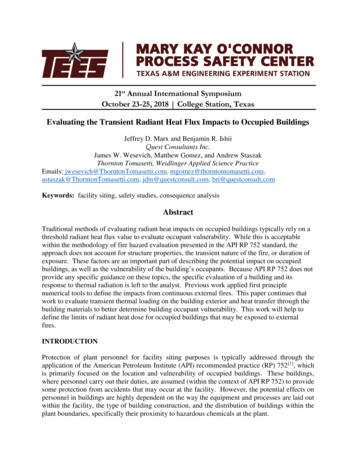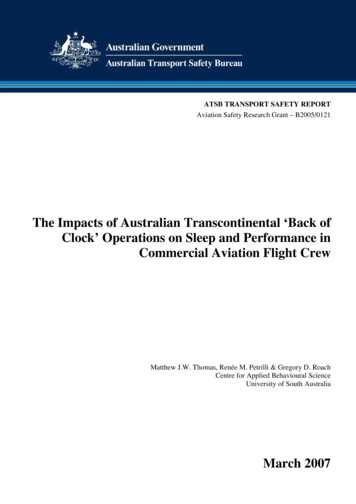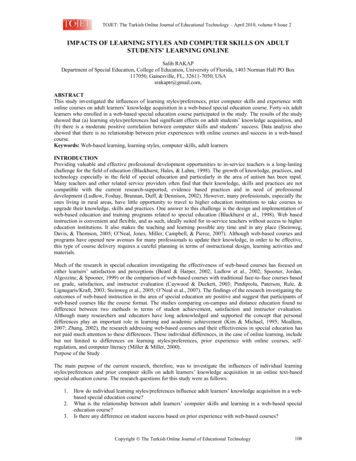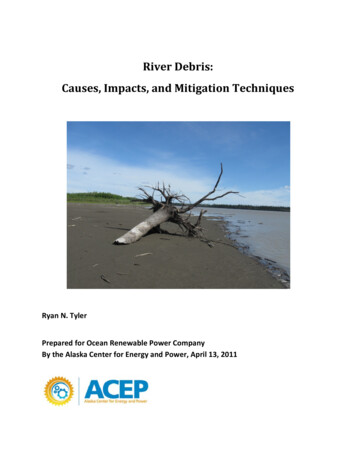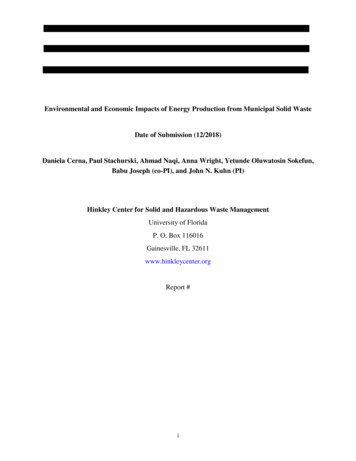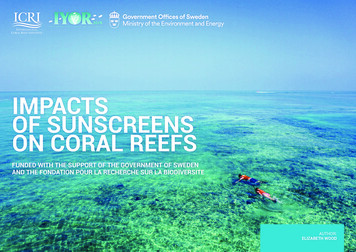
Transcription
ALATIVEIMPACTSOF SUNSCREENSON CORAL REEFSFUNDED WITH THE SUPPORT OF THE GOVERNMENT OF SWEDENAND THE FONDATION POUR LA RECHERCHE SUR LA BIODIVERSITEAUTHOR:ELIZABETH WOODImpacts of sunscreens on corals - ICRI briefing - Feb 20181
SUMMARYThis document responds to Goal 3(5) of the International Coral Reef Initiative (ICRI) Plan of Action 2016-2018, which seeks to reviewissues relating to the impact of sunscreens on coral reefs.Sunscreens contain organic (chemical) and/or inorganic(mineral) UV filters that absorb, reflect or scatter UVlight. They also contain inactive ingredients such as antimicrobial preservatives, moisturisers and l(benzophenone-3 and -4 (BP-3 or oxybenzone; BP-4),ethylhexyl methoxy cinnamate (EHMC), diethylamino hydroxybenzoyl hexyl benzoate (DHHB))and mineral (titanium dioxide and zinc oxide) UV filtershave been detected in coastal waters. UV filters reachcoastal waters either directly as a consequence ofwashing off swimmers and/or indirectly from wastewatertreatment plant effluents. Many of these componentshave also been found in marine biota including fish,molluscs and corals as well as in sediments.Where sunscreen components have been detected,concentrations are very variable. They are generallyfound at barely detectable levels of a few parts pertrillion but much higher concentrations of over 1 part permillion (ppm) have been reported in a few locations (e.g.1.395 ppm BP-3 reported by Downs et al (2015) in theUS Virgin Islands).A small number of studies have shown that sunscreenand certain individual components of sunscreen canhave negative effects on corals and other marineorganisms under certain circumstances. The chemicalUV filter oxybenzone has been studied most intensivelyand the following effects have been described: Bleaching of coral fragments and coral cells fromvarious species of hard coral. This effect is morepronounced at higher water temperatures. Induction of the lytic viral cycle in symbioticzooxanthellae with latent infections. Damage and deformation of coral larvae (planulae). Damage to coral DNA and to their reproductivesuccess.To date, experiments have largely been undertaken exsitu and there are concerns that they may not properlyreflect conditions on the reef, where pollutants could berapidly dispersed and diluted. In general, concentrationsof UV filters used in experimental work have been higherthan likely to be encountered in the reef environment.Most experiments have also been of relatively shortduration (12 or 24 hours). On the reef, while UV filtersmay be at lower concentrations, they can accumulate inorganisms and sediment and thus become persistent,with largely unknown consequences.Research to date has also concentrated mainly onthe effects of sunscreens and individual chemicals atsubcellular, cellular and individual organism level, withvery few studies of wider impacts.Further research is needed to better understand whichingredients are safe and which pose a realistic threat tomarine ecosystems, in particular: Determining concentrations of different sunscreencomponents in the water column, sediment and biota,comparing locations that are heavily visited and/oraffected by coastal run-off with those that are moreremote. Investigating the effects of sunscreen pollutants atreef community and ecosystem level. Exploring links between organismal or cellular/subcellular-level biomarkers that more easily allowthe study of pharmaceutical effects on biodiversity/community composition and ecosystem functioning. Investigating UV filter toxicity in relation to predictedwarming and ocean acidification conditions. Researching the extent and significance of bioconcentration and bio-accumulation of organic UVfilters as well as the consequences of long-term,chronic exposure to sunscreen pollutants. Studying the effects of pharmaceutical and personalcare products (PPCP) mixtures to provide a morerealistic picture of ecological risks posed by the useof these products. Identifying those ingredients that are safe and thosethat pose a realistic threat to marine ecosystems.Considering the many stresses already faced by reefsand current concerns about the toxicity of certaincomponents of sunscreens to corals, a proactive andprecautionary approach to dealing with this issue maybe required. Reducing the amount of harmful sunscreencomponents that reach the reef environment is a highpriority and will require the involvement of governments,reef managers, divers, snorkelers and swimmers, and thetourism and pharmaceutical industries. The followingmeasures are recommended: y Promoting the use of reef-friendly sunscreens andother methods of UV protection Regulating the sale and use of sunscreens containingtoxins Exerting consumer pressure to encouragedevelopment and use of eco-friendly sunscreens Introducing financial disincentives for manufactureand use of potentially damaging sunscreensImpacts of sunscreens on corals - ICRI briefing - Feb 20182
1/ INTRODUCTIONThere is intense concern about the future health andecological integrity of coral reefs in the face of globalclimate change. This is considered to be one of thegreatest threats to reefs worldwide and is causing coralbleaching and ecosystem change at unprecedentedlevels. Coral reefs are also under considerable stress fromoverfishing, destructive fishing, coastal developmentand pollution. There is universal agreement that coralreefs face an unpredictable future and that action needsto be taken at all levels if their integrity and values are tobe maintained.In recent years, a number of studies have shown thatsunscreens and other cosmetic products containchemical substances that are adding to the pollutionburden faced by coral reefs. Exposure to ultraviolet (UV)solar radiation poses a threat to public health, includingthe risk of sunburn, photo-aging and skin cancer (Pathak,1987), and growing concern about these harmful effectshas led to an increase in use of sunscreens. The world’scoastal population and coastal tourism are expected togrow during this century and it is anticipated that theuse of sunscreens and cosmetics containing UV-filterswill rise further. Given the status of reefs, it is essentialthat the impact of sunscreens on corals is assessed andaddressed.2/ COMPOSITION OF SUNSCREENSEarly sunscreens worked by providing a physical barrierbetween the skin and the sun’s rays but by the 1960s,the cosmetic industry had developed more complexsunscreens containing specific UV filters. These filterscome in two forms, organic (chemical) and inorganic(mineral), which act by absorbing, reflecting or scatteringUV light. Organic and inorganic filters are often used incombination to offer full protection against both UVA and UV-B radiation. They are also present in a largenumber of other pharmaceutical and personal careproducts (PPCPs).Organic filters include benzophenone-3 (BP-3; alsoknown as oxybenzone), benzophenone-4 (BP-4), paraaminobenzoic acid (PABA) and PABA esters, cinnamates,salicylates, camphor derivatives, dibenzoylmethanesand anthranilates (Chisvert et al., 2001; Danovaroand Corinaldesi 2003). These are generally usedin combination because no single one, at currentlypermitted concentrations, provides sufficient protectionagainst UV radiation. Sunscreens typically comprise upto 20 or more chemical compounds (Danovaro et al.,2008).The most widely used mineral filters are zinc oxide andtitanium dioxide, often in the form of nanoparticles (NPs)to avoid the whitening effect on the skin caused by thesecompounds. The International Cooperation on CosmeticRegulation defines a nanomaterial as an insoluble,intentionally manufactured ingredient with one or moredimensions ranging from 1 nm to 100 nm in the finalformulation (Auffan et al., 2009; Ansell et al., 2010).Other minerals used in sunscreens include silicatebased substances such as talc and kaolin. Sunscreensalso contain inactive ingredients such as anti-microbialpreservatives, moisturisers and anti-oxidants whichmay make up between 30 and 70% of the product.Impacts of sunscreens on corals - ICRI briefing - Feb 20183
3/ OCCURRENCE OF SUNSCREEN COMPONENTSIN THE MARINE ENVIRONMENTThis section reviews studies have been carried out toinvestigate the occurrence and concentration of UVfilters in seawater, marine sediments and biota. Theseare not confined to areas with coral reefs but providea broad picture of the range of sunscreen componentsthat reach the marine environment. Risk assessmentshave also been conducted to provide an indication of theenvironmental implications of this pollution.Organic and inorganic UV-filters reach coastal waterseither directly from people who have applied sunscreensbefore entering the water and/or indirectly fromwastewater treatment plant effluents (e.g. Daughton andTernes, 1999; Danovaro et al., 2008; Sánchez-Quiles andTovar-Sánchez 2015). Sunscreen ingredients, includingoxybenzone, BP-4, ethylhexyl methoxy cinnamate(EHMC), homosalate (HMS), 4-methylbenzylidenecamphor (4-MBC), diethylamino hydroxybenzoyl hexylbenzoate (DHHB), titanium dioxide and zinc oxide, havebeen detected in coastal waters (Daughton and Ternes1999; Giokas et al. 2007, Danovaro et al., 2008; TovarSánchez et al., 2013; Sánches Rodrίguez et al., 2015;Downs et al., 2015).The overall quantity of sunscreens that enter the oceanis not known, although some estimates have beenmade. Some 20,000 tons of sunscreen were estimatedby Corinaldesi (2001) to be released annually intothe northern Mediterranean. Danovaro et al (2008)estimated that 4,000-6,000 tons of sunscreen wash offpeople into coral reef areas each year but Downs et al(2015), citing Shaath and Shaath (2005), UNWTO (2007),Danovaro et al. (2008) and Wilkinson (2008), concludedthat 6,000-14,000 tons of sunscreen lotion are releasedinto coral reef areas each year. Downs et al (2015) notethat many of the lotions contain 1-10% of the UV filteroxybenzone and suggest that at least 10% of globalreefs and 40% of coastal reefs are at risk of exposure tothis chemical. However, to date, the level of exposurehas only been quantified at a few coral reef sites.part per million (mg/L) have been reported (e.g. 1.395ppm oxybenzone reported by Downs et al (2015) in theUS Virgin Islands). It is however, important to note, thatalthough the concentrations may be low, persistence oflow concentrations may have additive effects if thesechemicals are sequestered by marine organisms.Where sunscreen components have been detected,concentrations are very variable; most work has beenundertaken on oxybenzone and information for thischemical is summarised in Table 1. Sunscreen filtersare generally found at barely detectable levels of a fewparts per trillion (ng/L), but concentrations of over 1Impacts of sunscreens on corals - ICRI briefing - Feb 20184
TABLE 1/ CONCENTRATIONS OF OXYBENZONE (BP-3)REPORTED IN SHALLOW WATERS AT VARIOUS SITES.Further details for each of the countries/states where research has been undertaken are provided after the table.SITESAMPLING LOCATIONOXYBENZONE CONCENTRATIONUS VIRGIN ISLANDS: CARIBBEAN SEATrunk Bay 2007 (Downs et al., 2015)Shallow water adjacent to reef. 180 people in water prior to sampling580μg L-1 - 1.395 mg L-1Trunk Bay June 2013. (Bargar et al., 2015)2 samples at shoreline, 1 sample 30m from offshore island at 1m depth1,943 – 4,643ng L-1Trunk Bay June 2014.(Bargar et al., 2015, Fig 3 data supplied by Bargar)shoreline at 1m depth6,073 ng L-1Trunk Bay June 201460m from shore at 1m depth1,416 ng L-1Trunk Bay June 2014120m from shore at 1m depth363 ng L-1Trunk Bay June 2014220m from shore at 1m depth116 ng L-1Trunk Bay June 2014220m from shore at c 3m depth0 ng L-1Hawksnest Bay 2007 (Downs et al., 2015)Shallow water. 230 people in water prior to sampling75 - 95 μg L-1Caneel Bay 2007Shallow water. 17 swimmers in 48hr prior to samplingNot detectableFolly Beach S Carolina 2010(Bratkovics and Sapozhnikova, 2011)4 sites. Shallow water 1.5-2m from water line10 – 2,013 ng L-1S Carolina local Beach Front Park (Bratkovics et al., 2015)Shallow watermax 2,200 ng L-1SOUTH CAROLINA: NORTH WESTERN ATLANTICCANARY ISLANDS: EASTERN ATLANTIC (SÁNCHEZ RODRΊGUEZ ET AL., 2015)Gran Canaria Island May to Oct 20113 'semi-enclosed' beaches at 1 - 1.5m depth12.7 – 3,316 ng L-1Gran Canaria Island May to Oct 20113 'open' beaches at 1 - 1.5m depth 1.4 - 182.6 ng L-1Impacts of sunscreens on corals - ICRI briefing - Feb 20185
SITESAMPLING LOCATIONOXYBENZONE CONCENTRATIONCHINAHong Kong (Tsui et al., 2017)4 locations; wet and dry seasons12.9 - 31.9 ng L-1Shallow water 300-600m from beach0.4 - 3.8 ng L-1Oahu Island; Maunalua Bay May 20114 sites; 35cm depthDetectable 100 ng L-1; belowquantitative range of 5 μg L-1Maui Island: Kapalua Bay May 20111 site; 35cm depthOften 500 swimmers1 site: 19.2 μg L-1Detectable 100 ng L-1; belowquantitative range of 5 μg L-1Palau: Jellyfish Lake water. Jan 20168 samples. Tourist location: visited by tens of thousands of people.Marine lake water4.12 - 10.2 ng L-1 in 3 samples. Notdetectable in 4 samples; present butnot measurable in 1 sample.Palau: Jellyfish Lake, from inlet by tourist dock: 8 samplesJan 2016.8 samples. Marine lake water by tourist dock4.99 - 5.36 ng L-1 in 2 samples. Notdetectable in 6 samplesPalau: Outside Jellyfish Lake near outside dock: Jan2016.4 samples. Not a swimming areaNot detectable in any of 4 samplesPalau: Ngermeuangel Lake water. Jan 2016.8 samples. Marine lake water. Intended as control site away fromtourist areas4.4 to 18.5 ng L-1 at 3 sites; notdetected at 9 sitesPalau: lagoon outside entrance to Ngermeuangel Lake:Jan 2016.4 samples. Not a swimming areaNot detectable in any samplePalau: Ocean outside Lighthouse Reef4 samples: control siteNot detectable in any sampleJAPANOkinawa (Tashiro and Kameda, 2013)HAWAII (DOWNS ET AL., 2015)PALAU (BE
against UV radiation. Sunscreens typically comprise up to 20 or more chemical compounds (Danovaro et al., 2008). The most widely used mineral filters are zinc oxide and titanium dioxide, often in the form of nanoparticles (NPs) to avoid the whitening effect on the skin caused by these compounds. The International Cooperation on Cosmetic
